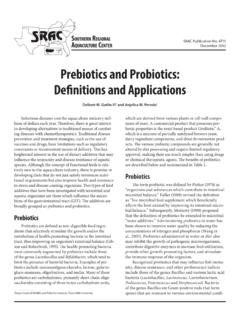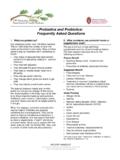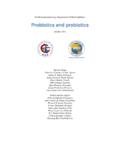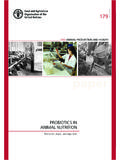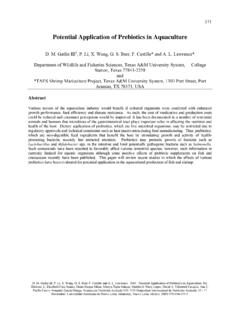Transcription of PROBIOTICS, PREBIOTICS AND THE GUT …
1 Food International Life Sciences InstituteILSI EUROPE CONCISE MONOGRAPH SERIESPROBIOTICS, PREBIOTICS AND THE GUT MICROBIOTAI nternational LifeSciences Institute ABOUT ILSI / ILSI EUROPEF ounded in 1978, the International Life Sciences Institute (ILSI) is a nonprofit, worldwide foundation that seeks to improve the well-being of the general public through the advancement of science. Its goal is to further the understanding of scientific issues relating to nutrition, food safety, toxicology, risk assessment, and the environment. ILSI is recognised around the world for the quality of the research it supports, the global conferences and workshops it sponsors, the educational projects it initiates, and the publications it produces.
2 ILSI is headquartered in Washington, DC. It is affiliated with the World Health Organization (WHO) as a non-governmental organisation and has special consultative status with the Food and Agriculture Organization (FAO) of the United European branch ILSI Europe was established in 1986. ILSI Europe fosters collaboration among the best scientists to provide evidence-based scientific consensus on the areas mentioned above. By facilitating their collaboration, ILSI Europe helps scientists from many sectors of society public and private to best address complex science and health issues by sharing their unique knowledge and Europe advances the understanding and resolution of scientific issues through expert groups, workshops, symposia and resulting publications.
3 The ultimate goal of ILSI Europe is the improvement of public ILSI Europe activities are conducted under the supervision of the Scientific Advisory Committee. With its balanced composition, the Scientific Advisory Committee plays an important role in reviewing all activities with respect to their scientific validity and coherence with ILSI Europe s programme. The Scientific Advisory Committee provides scientific advice to the Board of Directors. ILSI policy mandates that the ILSI and ILSI branch Boards of Directors must be composed of at least 50% public sector scientists; the remaining directors represent ILSI s member publication is made possible by support of the ILSI Europe PREBIOTICS and probiotics Task Forces.
4 Industry members of these task forces, as well as the composition of the Board of Directors and the Scientific Advisory Committee are listed on the ILSI Europe website at opinions expressed herein and the conclusions of this publication are those of the author and do not necessarily represent the views of ILSI Europe nor those of its member , PREBIOTICS AND THE GUT MICROBIOTAby Nino Binns 2013 ILSI EuropeThis publication may be reproduced for non-commercial use as is, and in its entirety, without further permission from ILSI Europe. Partial reproduction and commercial use are prohibited without ILSI Europe s prior written permission. A Global Partnership for a Safer, Healthier World.
5 , the International Life Sciences Institute (ILSI) logo image of concentric circles, the word mark International Life Sciences Institute , as well as the acronym ILSI are trademarks of the International Life Sciences Institute and licensed for use by ILSI Europe. The use of trade names and commercial sources in this document is for purposes of identification only and does not imply endorsement by ILSI Europe. For more information about ILSI Europe, please contactILSI Europe E. Mounier 83, Box 6B-1200 BrusselsBelgiumTel.: (+32) 2 771 00 14 Fax: (+32) 2 762 00 44E-mail: in BelgiumD/2013 : 9789078637394 ISSN 2294-5490 FOREWORD 1 INTRODUCTION 2 ROLE OF THE GI TRACT microbiota IN HEALTH AND DISEASE 4 microbiota of the GI tract 4 Bacterial fermentation and metabolism 6 The GI epithelial barrier and immune system 8 Techniques for exploring the GI microbiota
6 10 THE PROBIOTIC CONCEPT 11 Definition and history 11 Selection of probiotic candidates 12 Characterisation and taxonomy 12 Safety 13 Application of probiotics in food 14 THE PREBIOTIC CONCEPT 14 Definition and history 14 Characterisation of prebiotic ingredients 14 Criteria for prebiotic selection 15 Application of PREBIOTICS in food 15 HEALTH EFFECTS OF PREBIOTICS AND probiotics 16 Research challenges 16 Impact on the GI tract of PREBIOTICS and probiotics 16 Impact on the GI tract specific to PREBIOTICS 18 Impact on the GI tract specific to probiotics 20 Impact on the immune responses 20 probiotics AND PREBIOTICS .
7 MECHANISMS OF ACTION 23 Overall mechanism 23 GI tract and its microbiota 23 Cross-talk with the host 25 OVERALL CONCLUSIONS 27 ABBREVIATIONS 29 GLOSSARY 30 SOURCE MATERIAL AND FURTHER READING 31 CONTENTSA uthor: Nino Binns, NB Consulting (UK)Scientific Editors: Glenn.
8 R. Gibson, University of Reading, (UK); Mary Ellen Sanders, International Scientific Association for Pro & PREBIOTICS (US)Scientific Reviewers: Nathalie Delzenne, Universit Catholique de Louvain (BE) and Lorenzo Morelli, Catholic University of Piacenza, (IT)Concise Monograph Series Editor: John Howlett (UK)Coordinators: Agn s M heust, Massimo Ambrosio and Alessandro Chiodini, ILSI Europe (BE) probiotics , PREBIOTICS and the Gut microbiota 1 Since the introduction of the concept of functional foods in Japan in the 1980s, there has been growing interest in the concept of PREBIOTICS and probiotics , and the synergistic combination thereof, called synbiotics, and their role in human nutrition.
9 Pre- and probiotics are now commonly found in a range of products for infants, young children and adults. What is it that makes the consumer interested in these ingredients? By definition, both pre- and probiotics should convey health benefits. The general population is increasingly interested in maintenance of health and self-care and this may explain the consumers interest. Both pre- and probiotics elicit their effects, at least to some extent, through modulation of the intestinal microbiota (formerly called microflora). The results of multidisciplinary research efforts to understand the composition and function of the intestinal microbiota , as well as the role of pre- and probiotics , have recently been published.
10 A summary of these findings is therefore both appropriate, in the context of pre- and probiotics , and of the lack of easily understandable and objective information on the topic for the interested non-specialist life scientist, ILSI Europe Task Forces on both PREBIOTICS and probiotics decided to initiate the writing of a Concise Monograph with input from experts in the purpose of the monograph is to discuss in understandable terms the current abundant scientific knowledge on PREBIOTICS , probiotics and the intestinal microbiota , including the resulting effects on the host. The monograph does not address the detailed regulatory aspects of the topic.



